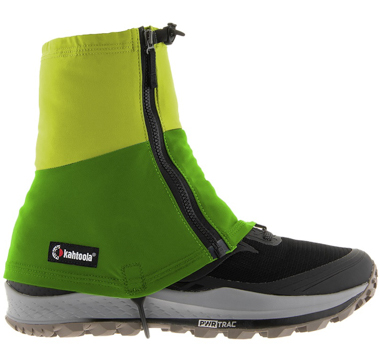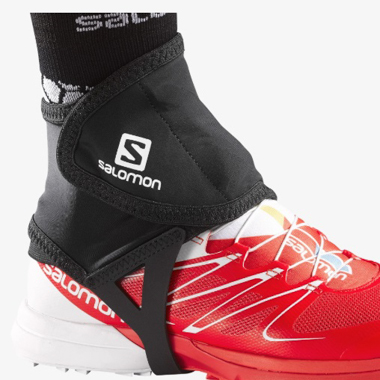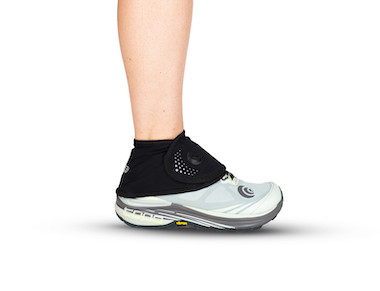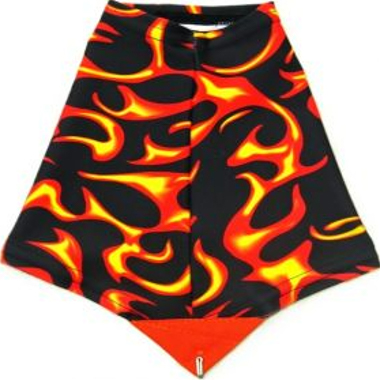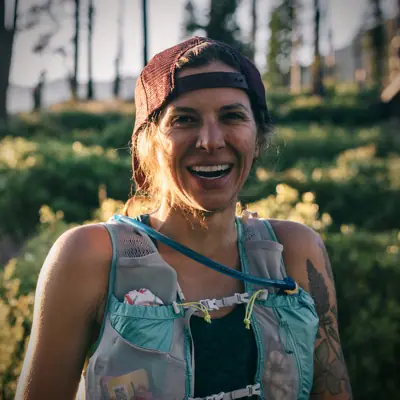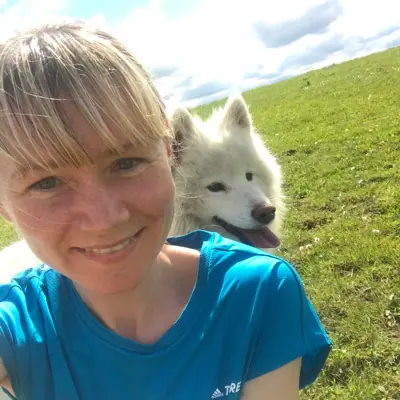
Trail running in Colorado with the Altra Trail Gaiter, which we awarded the best hot-weather running gaiter. Photo: iRunFar/Eszter Horanyi
If you’re familiar with the joy of running down a slope of soft scree — a common experience for runners on the U.S. Pacific Northwest’s crumbly volcanoes, for example — you know that once you get to the bottom, you need to sit down and dump debris out of your shoes before continuing on your way.
The best running gaiters — light, breathable, and protective — can keep rocks and debris out of your shoes without causing your feet to overheat. This can reduce the chance of blisters and minimize discomfort caused by small pieces of debris.
Running gaiters are lighter and less bulky than traditional gaiters for hiking and mountaineering. They only cover the top of the shoe and ankle. They tend to be water-resistant rather than waterproof, making them more breathable. If your trail running takes you off the trail or through mud, scree, brush, or lots of dust, gaiters could be a worthwhile addition to your gear bin.
However, even among running-specific gaiters, some notable differences exist in materials, style, fit, and shoe attachment systems. Below, we’ve rounded up the best trail running gaiters currently available and highlighted the conditions in which they excel.
We loved the Kahtoola INSTAgaiter Mid for all-around use, while we turned to the inov8 All Terrain Gaiter for cold and wet conditions. When heat was a consideration, we turned to the Altra Trail Gaiter. For more background information, see our buying advice, testing methodology, and frequently asked questions.
Best Running Gaiters
- Best Overall Running Gaiters: Kahtoola INSTAgaiter Mid
- Best Running Gaiters — Runner-Up: REI Co-op Swiftland Running Gaiters
- Best Running Gaiters for Hot Weather: Altra Trail Gaiter
- Best Running Gaiters for Cold Weather: inov8 All Terrain Gaiter
- Best Minimalist Running Gaiters: Salomon Trail Gaiters Low
- Best Minimalist Running Gaiters — Runner-Up: Topo Performance Gaiter
- Best Budget Running Gaiters: Dirty Girl Gaiters

Kyle Curtin runs in the Dirty Girl Gaiters in Colorado. The Dirty Girl Gaiters received our best budget running gaiters award. Photo: iRunFar/Eszter Horanyi
Best Overall Running Gaiters: Kahtoola INSTAgaiter Mid ($50)
- Multiple adjustment points for a precise fit on any shoe
- High-quality materials and construction
- Mid-height provides significant protection from brush and rocks to feet and ankles
Cons:
- High price point
- It could be too much gaiter for some environments
When it comes to a high-quality and durable trail running gaiter, the Kahtoola INSTAgaiter Mid has you covered — literally. Of all the gaiters in this guide, it provides the most comprehensive coverage over the shoe while still being lightweight. This gaiter features a stretch-woven nylon blend, a sturdy YKK zipper, and the brand’s DuraLink instep strap. Yet, it weighs just 2.4-2.7 ounces per pair, depending on size.
These gaiters combine the best of all worlds by being highly protective while still being lightweight enough to be essentially unnoticeable once on. The material is thin enough to easily ball the gaiter up in your fist. We tested these gaiters in a variety of weather conditions and on many types of trails.
After many miles on rocky trails, they showed very little sign of wear and effectively kept debris out of our shoes. They also performed admirably at keeping our feet dryer when running in muddy and slushy conditions. The material did a great job shedding mud, though thicker mud tended to build up on the instep attachment points.
This gaiter comes in two heights: the mid-height comes about a hand’s width above the ankle and will likely cover your running socks, and the low height is about 2.5 inches shorter and covers just above the ankle. We preferred the mid-height version for its extra coverage of our ankles and lower legs.
A front hook and an adjustable instep strap attach to any trail running shoe with a secure fit. One of our testers found that the front attachment hook would come off the laces when traveling off-track on tussocky and bushy terrain in New Zealand, where vegetation grabbed everything. Still, even with the front hook undone, the gaiter stayed in place.
The top of the gaiter also cinches closed to keep the gaiter in place and prevent debris from entering at the top. While we experienced a little bit of sag when the gaiter was wet, it wasn’t bad enough to consider it an issue.
The breathable nylon-blend fabric is treated with a durable water-repellent (DWR) coating to repel water, and the zipper is backed with the same fabric to prevent water seepage and chafing if you’re wearing low socks. This gaiter is easy to take on and off without removing your shoe.
Material: 84% stretch-woven nylon/16% polyurethane blend with a durable water-repellent (DWR) coating
Shop the Kahtoola INSTAgaiter MidBest Running Gaiters — Runner-Up: REI Co-op Swiftland Running Gaiters ($30)
- Adjustable elastic cord tucks out of the way
- Grippy material inside the top cuff keeps the gaiter in place
- Breathable, quick-drying fabric
Cons:
- Limited durability
- Requires removing your shoes to put the gaiter on/take it off
When testing the REI Co-op Swiftland Running Gaiters, we were impressed with how easy it was to forget we were even wearing gaiters. Lightweight and breathable, these gaiters fit like a comfortable sock that just so happens to attach to the outside of your shoe. There’s subtle grippy material inside the top cuff that prevents the gaiters from slouching while also helping keep dust and debris from entering.
The material breathed well, dried quickly, and shed mud splatters. While the stitching held up well during testing, we did notice a hint of abrasion on the fabric inside the ankles, so our hunch is that these gaiters could have limited durability in the roughest terrain.
The front hook and adjustable elastic cord attach to any trail running shoe. These gaiters also have a piece of Velcro on the back that works with nearly any shoe with a gaiter trap, which is essentially a piece of Velcro on the heel of the shoe. Altra and several other shoes come with a gaiter trap included. You can add a gaiter trap to nearly any pair of shoes by superglueing a small patch of Velcro to them. If you do this, you can remove the elastic cord under the shoe.
Material: 76% polyester/24% spandex
Shop the REI Co-op Swiftland Running GaitersBest Running Gaiters for Hot Weather: Altra Trail Gaiter ($20)
- Lightweight and breathable
- Quick-drying fabric
Cons:
- Fit is slightly loose around the collar of the shoe
- Limited durability
Weighing just 1.3 ounces per pair, the Altra Trail Gaiter is one of the lightest and most breathable gaiter options available.
This gaiter is perfect for dusty trails and hot desert running. It features an airy nylon-spandex blend that’s quick-drying and durable enough for all but the most rugged environments. While these gaiters have held their own on the U.S. Pacific Northwest’s volcanic rock, they really shine on hot trails where breathability matters as much as keeping the dust out of your shoes.
They’ve proven their worth on the scree fields of the San Juan Mountains of Colorado, where long descents on loose rock often require stopping to remove shoes to clear them of debris. iRunFar gear editor Eszter Horanyi wore these gaiters on her 57-hour romp through the Sawatch Mountains of Colorado to set an unsupported FKT on the Nolan’s 14 line.
The simple attachment system is designed specifically for Altra’s trail shoes. However, these gaiters can work for just about any shoe if you purchase some self-adhesive Velcro and install it on the back of your favorite trail running shoes. They fit fairly well and stay in place, but they are a little loose around the bottom, which causes us some doubt about their performance in ankle-deep sand or scree. We wouldn’t choose to use these gaiters in situations where we were traveling off-trail through dense underbrush that could push the sides of these gaiters up and deposit debris in our shoes.
Material: 82% nylon/18% spandex
Shop the Altra Trail GaiterBest Running Gaiters for Cold Weather: inov8 All Terrain Gaiter ($20)
- Highly water-resistant
- The knitted ankle cuff is snug and comfortable
- Compatible with any shoe using rubber O-rings
Cons:
- Not quick-drying
- Hook attachments are not compatible with all inov8 trail running shoes
- Multiple detachable (thus, mis-placeable) parts with the O-rings
For shoulder-season running that involves chilly temperatures, slushy trails, and sloppy mud, we recommend the inov8 All Terrain Gaiter. Coming from a brand that focuses on gear that will perform in the wet, muddy terrain of the fells of England, it’s no surprise that these gaiters excel in these conditions.
These gaiters feature a knitted ankle cuff and a highly water-resistant fabric. We tested them by holding them under a running faucet. In wet conditions, they outperformed every other gaiter we tested for keeping mud out of our shoes.
The downside of the double-layer, water-resistant fabric is that it doesn’t breathe well or dry quickly. We found that several hours after a run, these gaiters were still damp around the ankle from lingering sweat. We got the same result after the faucet test — it wasn’t easy to soak them, but after four hours of sitting out, they were not completely dry.
Inov8 designed these gaiters for conditions when shoes and other running gear never completely dry out, and they will stay warm even when wet. Whether you’re using these gaiters in damp or dry conditions, you’ll only want them if it’s cold out. We don’t recommend them for warmer, humid conditions.
The brand constructed these gaiters to work well whether you run in inov8 shoes or not. They are compatible with select inov8 trail running shoes using a built-in attachment system with metal hooks, but they will work with any trail running shoes using the included O-rings.
This system works well enough — when the gaiter is on the shoe. But since the O-rings don’t attach securely to the metal hooks, they can fall off when you take the gaiter off and easily get lost in a gear pile.
Material: 90% polyester/10% polyamide
Shop the inov8 All Terrain GaiterBest Minimalist Running Gaiters: Salomon Trail Gaiters Low ($40)
- Easy on/off
- Durable construction
- Low height provides ample protection with moderate coverage
Cons:
- Relatively heavy
- Could chafe the top of the ankle
If you want a pair of gaiters that cover as little as your shoe as possible while still keeping rocks out, the Salomon Trail Gaiters Low are minimalist gaiters that provide a surprising amount of protection for how small they are. One of the unique features of these gaiters is that you can set how tight they are around your ankle. They are easy to take on and off, even with your shoes on, and you can use them with any shoe.
The fabric is thicker than many other gaiters in this guide, but it has enough stretch to fit snugly around the top of the shoe and provide a seal around the shoe collar. They work well as an everyday gaiter in all but the muddiest or sandiest conditions.
The underfoot strap is quite thick and durable and easily stays in place, even on rough terrain. The hook-and-loop closure keeps the back of the gaiter in place on technical and rocky terrain. The durable materials and construction come with a cost. At 4.3 ounces for the pair, they’re about twice as heavy as comparable gaiters, such as the Kahtoola INSTAgaiter Mid, which weighs 2.4 to 2.7 ounces per pair thanks to its stretch-nylon blend, and the Topo Performance Gaiter, which weighs even less at 1.8 to 2 ounces per pair.
At first glance, we were worried that these gaiters could chafe the top of the ankle, but after extensive use, we haven’t had any issues.
Material: 78% polyamide/22% elastane on the front face/100% polyester on the back face
Shop the Salomon Trail Gaiters LowBest Minimalist Running Gaiters — Runner-Up: Topo Performance Gaiter ($30)
- Secure attachment with three hooks
- Easy on/off
- Durable construction
Cons:
- Only compatible with Topo trail shoes
- Could chafe the top of the ankle
If you prefer Topo trail running shoes, the Topo Performance Gaiter is an easy addition to your next pair of fresh kicks. These gaiters include three hooks — two in the back and one in the front — that attach to the built-in loops on all Topo trail running shoes.
They’re easy to put on and take off without any underfoot straps, and you don’t need to take your shoes off to do so. Along with the hook attachments, the gaiters wrap around the top of the shoe and secure in place with an overlapping hook-and-loop closure. The design does a great job of keeping dirt and debris from getting inside the shoe. The gaiter fabric doesn’t have a ton of stretch, and once they’re in place, they don’t budge. The fabric is thick and durable, yet it still breathes well.
We learned the hard way that these gaiters can and will chafe if you don’t wear socks underneath them. They’re minimalist enough that it’s easy to forget they’re on — until you’re losing skin where the thick seams overlap. It’s an easy fix if you wear running socks that reach above the top of the gaiter, so we’re still big fans.
Material: Stretch nylon/polyester trim
Shop the Topo Performance GaiterBest Budget Running Gaiters: Dirty Girl Gaiters ($23)
- Lightweight
- Breathable
- Secure fit
Cons:
- Requires Velcro (included)
- Limited durability
Dirty Girl Gaiters started in 2004 after its founder, Xy Wiess, made leopard-print gaiters to wear at the Western States 100. Since then, the woman-owned company based in Tucson, Arizona, has grown an international presence in the trail running and thru-hiking communities. While the gaiters are available at select retail stores in the United States and internationally, you can find the full selection of colors, patterns, and sizing information on the brand’s website.
These gaiters feature a polyester and Lycra blend similar to a bathing suit material. At just 1.5 ounces for the pair, they’re lightweight, and we found the material to be breathable. With the addition of these gaiters, our feet never felt like they were overheating. The top of the gaiter reaches a few inches above the ankle, and the fabric holds enough structure to stay securely in place.
They’re constructed similarly to the Altra Trail Gaiter and other over-the-shoe gaiters, with a hook in the front and a Velcro patch in the back that will work on just about any trail shoe. You have to install the self-adhesive Velcro yourself, but each set of gaiters comes with a 6-inch strip of adhesive that provides more than enough for a couple of pairs of shoes.
Once installed, these gaiters provided a secure fit and kept dust, dirt, and debris out of our shoes. However, these stretchy, lightweight gaiters have limited durability, so you might rethink bushwhacking through brambles or scraping against sharp rocks.
Without a strap going under the shoe, they’re also prone to getting pushed up if traveling off-trail in bushy terrain, allowing debris into the shoe. Overall, they’ll perform great in most trail running applications.
Material: 83% polyester/17% Lycra
Comparing the Best Running Gaiters
| GAITER | PRICE | HEIGHT | WEIGHT |
| Kahtoola INSTAgaiter Mid | $50 | 8 inches | 2.1 ounces |
| REI Co-op Swiftland Running Gaiters | $30 | 6.5 inches | Not listed |
| Altra Trail Gaiter | $25 | Not listed | Not listed |
| inov8 All Terrain Gaiter | $33 | 10 inches | 1.76 ounces |
| Salomon Trail Gaiters Low | $35 | 5 inches | 3.88 ounces |
| Topo Performance Gaiter | $30 | Not listed | 2 ounces |
| Dirty Girl Gaiters | $20 | Not listed | Not listed |

The secure fit of the Kahtoola INSTAgaiter Low makes them a good choice for brushy, overgrown travel. Photo: iRunFar/Eszter Horanyi
How to Choose: A Buyer’s Guide for the Best Running Gaiters
Comfort and Fit
Comfort and fit are among the most important factors when choosing the best running gaiters. Many factors influence how a gaiter fits, including the materials and fabric, the height of the gaiter and where it sits on your leg, breathability, water resistance, and whether it provides a snug or loose fit.
Some trail running gaiters reach a few inches above the ankle, while more minimalist styles just barely cover the shoe collar. The Salomon Trail Gaiters Low and Topo Performance Gaiter provide a minimal look and feel, but they could chafe without protection from ankle- or crew-height running socks.
The fit of gaiters can vary. Some, like the inov8 All Terrain Gaiter, provide a snug fit against the shoe and leg, while others, like the Dirty Girl Gaiters, provide a looser, more airy fit. It’s important that gaiters fit relatively snugly around the edges to keep debris out, but the rest of the material can be looser or tighter, depending on your preference.
When choosing your gaiter size, we recommend referencing the size guide on the product page website. Many gaiters have an adjustment mechanism to snug them up, while others use elastic.

iRunFar’s Meghan Hicks pulls her gaiters up to dry out wet feet during her Nolan’s 14 FKT run. Photo: iRunFar/Eszter Horanyi
Custom Compatibility Versus Universal Attachment
If you’re already running in a shoe brand that makes a custom running gaiter, choosing the gaiter built for your shoe is easy and convenient. However, some of these brand-specific gaiters can accommodate any shoe with some modification. The inov8 All Terrain Gaiter comes with O-rings, and nearly any shoe can work with the Altra Trail Gaiter by adding a small piece of Velcro on the heel.
Additionally, a variety of gaiters available can work for just about any trail running shoe without modification. Kahtoola INSTAgaiter Mid and Salomon Trail Gaiters Low attach to any trail running shoe via an underfoot strap and front hook, while the Dirty Girl Gaiters feature a front hook and gaiter-trap design for over-the-shoe attachment.

The gaiter-trap attachment system on the Altra Trail Gaiter works seamlessly with Altra shoes and, with the addition of a small piece of Velcro, can work with any shoe. Photo: iRunFar/Eszter Horanyi
Water-Resistance and Breathability
The environments and trail surfaces where you’ll use gaiters — high alpine granite and shale, hot and dusty trails, or muddy and humid environments — will help guide the best trail running gaiter for your needs. You’ll want to balance breathability and water resistance when choosing a gaiter.
If you’re in a cool or wet environment, you may opt for a water-resistant gaiter that comes up higher on your leg, such as the Kahtoola INSTAgaiter Mid or inov8 All Terrain Gaiter. If you’re in a relatively dry and dusty environment, you might opt for the lightweight breathability of the Altra Trail Gaiter or the Dirty Girl Gaiters.
Gaiter Height
Trail surfaces and conditions will inform an appropriate gaiter height. If you’re in mud, sand, deep scree, or thick brush, a running gaiter that reaches higher on your leg will better keep debris out of your shoes. The tradeoff is that any fabric covering your ankles and shoes will inhibit breathability. While the fabric of the Kahtoola INSTAgaiter Mid reaches higher than most of the other gaiters in this guide, it’s light enough that we didn’t have any overheating issues with it.
If you primarily run on buffed-out trails and simply want to keep dust and pebbles out of your shoes, the best running gaiter will have minimal coverage, such as the Salomon Trail Gaiters Low or the Topo Performance Gaiter.

A close-up shot of the Dirty Girl Gaiters. We named these the best budget running gaiters. Photo: iRunFar/Eszter Horanyi
Durability
Gaiters feature various materials, and some are more durable than others. Because they are close to the ground, they’ll likely encounter rocks, brush, and other tear-causing elements on the trail, which means they need to be tough. However, increased durability can also mean less breathability, which can lead to hot and sweaty feet — which could create a shoe environment that increases the chance of blisters.
If you know that you’re going to be using your gaiters in off-trail settings or conditions or rocky trails, it’s worth investing in a more durable pair of gaiters, like the Kahtoola INSTAgaiter Mid. If you’re running on mostly smooth trails trying to keep dust and small rocks out or running in hot environments where you need a more breathable gaiter, it’s worth going for something more lightweight, like the Dirty Girl Gaiters.
Why You Should Trust Us
The iRunFar team comprises road, trail, and ultrarunners with hundreds of years of combined running experience. We began this running gaiters buyer’s guide with extensive research into the gaiters marketplace and polled our team for the opinions on gaiters that they’ve used over the years.
From there, author Alli Miles refined a list of the top choices and took nearly a dozen gaiters into the field, where she tested them over many miles and in all kinds of conditions. From hot, dusty gravel roads to slushy snowmelt and sloppy, muddy trails around where she lives and runs in Central Oregon, she tested gaiters over many miles and rated them on their breathability, comfort, ease of use, and the level of protection they provided.
We continue to test new gaiters and keep the ones in this guide in our rotation to uncover any durability issues. Our testing ranges far and wide, including the notoriously wet and muddy backcountry of New Zealand. We evaluate gaiters on their fit, ease of use, durability, breathability, and ability to keep debris out of our shoes. We update this guide whenever we discover a new gaiter that meets our performance standards.

iRunFar’s Eszter Horanyi sets a new unsupported Nolan’s 14 FKT wearing a pair of Altra Trail Gaiter. Photo: Kevin Schmidt
Frequently Asked Questions About Running Gaiters
What’s the purpose of running gaiters?
The primary purpose of running gaiters is to keep dirt, rocks, and other debris from getting inside your shoes and causing pain or blisters. Some of the higher gaiters, like the Kahtoola INSTAgaiter Mid, can also keep burrs and other plants that want to go for a ride from attaching to your socks.
Gaiters are most frequently used by those putting in a lot of miles on terrain where small rocks can get into shoes. This can include scree slopes, off-trail routes, and brushy and overgrown terrain. With gaiters, you’ll spend less time stopping to empty your shoes of rocks and minimize the chance of having your feet get irritated by small pebbles hitching a ride in your shoes.
Even a small amount of dirt between your feet and your shoes can cause friction and irritation, and gaiters such as the Altra Trail Gaiter will keep out light debris. Gaiters that cover much of your foot, like the Kahtoola INSTAgaiter Mid, can keep fine dust and sand out of your shoes. This can keep dirt from building up between your toes and causing blister-causing friction. Racers in the Marathon de Sables, which has stages traversing the very sandy Saharan Desert, use gaiters that cover their whole shoe to keep sand out and protect their feet.
While not necessarily an essential piece of gear for many runners, running gaiters can significantly improve their comfort on long, high-mileage days or when tackling a wider variety of terrain and trail conditions.

Putting on the Kahtoola INSTAgaiter Low gaiters. We tested this, and the Kahtoola INSTAgaiter Mid gaiters, which are slightly taller gaiters. Photo: iRunFar/Eszter Horanyi
What’s the difference between hiking gaiters and running gaiters?
There are a few key differences between hiking gaiters and running gaiters. First, hiking gaiters are generally taller and designed to cover the top of hiking boots, whereas running gaiters stop at the top of the shoe or a couple of inches above the ankle. Some are very minimalist, like the Topo Performance Gaiter.
Hiking gaiters employ stiff, sturdy, highly durable materials and are usually waterproof. They can keep boots dry through rainy weather or creek crossings — possibly over multiday hiking or backpacking trips where there may not be an opportunity to dry out boots. Companies also design hiking gaiters to withstand abrasive brush and brambles and to protect against poison ivy, poison oak, snake bites, and ticks.
Traditional hiking gaiters are too heavy and cumbersome for running. Since we’re generally not as concerned about wet socks, given that our shoes aren’t waterproof, we don’t need a heavy-duty waterproof gaiter.
Instead, runners mostly want to keep dirt and small rocks out of their shoes and prefer minimal weight and breathability over heavy but durable materials. As a result, running gaiters sacrifice some durability and waterproofness for the sake of nimbleness and allowing shoes to breathe.
If you’re traveling over terrain where you want extra protection from your shins and lower legs but don’t want to wear full hiking gaiters, the orienteering scene has come up with an alternative. Trimtex Speed TX O-Gaiters offer knee-high protection with a high level of breathability. They are made of stretchy Lycra mesh and have a strip of foam padding on the front of the shin to protect against rocks and spikey plants.
You’ll still have to wear a pair of normal running gaiters over them to keep rocks out of your shoes, but they are light enough for running and don’t feel much warmer than wearing a tall pair of socks.

The Salomon Trail Gaiters Low. In this guide, we named these the best minimalist gaiters. Photo: iRunFar/Eszter Horanyi
When should I use gaiters for running?
Running gaiters are a good option for long distances or travel over loose, challenging terrain, especially if many little rocks are around. When you’re on your feet for several hours at a time and covering a lot of ground, gaiters can improve comfort by keeping debris out of your shoes and save you time by eliminating the need to stop and dump dirt or silt.
This becomes more important on terrain with loose dirt, scree, mud, fine dust, sand, or other elements that can easily get inside your shoes and cause discomfort. Gaiters can also help keep debris out if traveling in silty waterways.
If you’re finding that you’re frequently dealing with annoying pebbles in your shoes that you’re constantly trying to move to a more comfortable spot or have to stop often on your runs to empty your shoes, you might benefit from a pair of the best running gaiters. The REI Co-op Swiftland Running Gaiters work well on a mix of terrain and are so comfortable you can forget you are wearing them.
Are trail running gaiters worth it?
Not everyone needs gaiters, but many people could benefit from them. You may not need gaiters if you’re running on buffed-out, well-trafficked trails, and your feet stay relatively dry and clean. On the other hand, if you’re spending long days on mountain trails that could be wet, muddy, snowy, rocky, dusty, or a combination of all of the above, gaiters could be a great addition to your trail running kit.
If you’re running when it’s wet, gaiters like the inov8 All Terrain Gaiter will provide good protection in wet, muddy conditions, while something lightweight, like the Topo Performance Gaiter, will perform better in dry, dusty conditions.
If you’ve experienced discomfort or blisters from debris getting in your shoes or are tired of having to stop to empty rocks out of your shoes during your runs, running gaiters will be a worthwhile investment. The good news is that a range of gaiters is available to meet a variety of needs and budgets.

We tested the Kahtoola INSTAgaiter Low gaiters on various terrains to determine how well they kept out various types of trail debris. Photo: iRunFar/Eszter Horanyi
Are trail running gaiters waterproof?
While some of the best running gaiters are water-resistant, including the inov8 All Terrain Gaiter, which excels in wet and muddy conditions, they are generally not waterproof. Since our shoes tend to be quick-drying and not waterproof, runners prefer breathability over waterproofness for gaiters.
Waterproof fabric inhibits breathability and slows the drying process, which can result in sweaty, uncomfortable feet and possibly blisters. Breathability will keep feet cooler and allow feet, socks, and shoes to dry more quickly.
Unlike mountaineers, hikers, or backpackers who may opt for traditional knee-high waterproof gaiters to cover waterproof boots, trail runners typically wear gaiters to keep debris out, not water. The breathable, quick-drying upper material of most trail running shoes will let water in regardless, and there’s no point in having waterproof gaiters to keep water from getting in around the ankle collar. A set of waterproof gaiters could be beneficial if you’re wearing waterproof shoes, but it’s probably not worth the effort.

Dirty Girl Gaiters perform well in dry, dusty environments and can keep small trail debris out of shoes. Photo: iRunFar/Eszter Horanyi
What gaiters are best for running in the sand?
Perhaps the most pervasive sediment on our home planet, there’s seemingly nowhere that sand can’t reach. Sand is highly abrasive and can quickly cause blisters if allowed to work its way between your toes or under the sole of your foot. Blisters are not only painful, but they can also get infected and turn into a significant issue.
If you frequently run in the sand, your feet will thank you for an investment in a pair of gaiters like the Altra Trail Gaiter and the Dirty Girl Gaiters. They provide good coverage around the top of the shoe to keep sand from getting in through the mesh upper material while staying breathable and light.
What gaiters are used for the Marathon des Sables?
The six-day, 251-kilometer race in southern Morocco’s Sahara Desert is deemed one of the toughest ultramarathon races. Among the extremes that Marathon des Sables runners face is lots of sand. The multiday nature of the race makes it incredibly important for runners to keep their feet in good shape, which means keeping sand out of shoes.
For this race, runners choose full-shoe gaiters like those made by Raidlight and myRaceKit. While we didn’t test any gaiters designed to cover the entirety of the upper of a shoe, the Kahtoola INSTAgaiter Mid provided the highest level of coverage and will keep most sand and debris out of your shoe.

iRunFar’s Meghan Hicks, former winner of Marathon Des Sables, struggles in Arizona sand without gaiters. Photo: iRunFar/Eszter Horanyi
Call for Comments
- We want to hear about your favorite trail running gaiters! Leave a comment to share which gaiters you love, and tell us in what conditions they perform best for you.
- If you choose not to wear gaiters, please let us know why.
